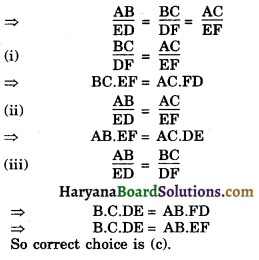Haryana State Board HBSE 10th Class Maths Important Questions Chapter 6 Triangles Important Questions and Answers.
Haryana Board 10th Class Maths Important Questions Chapter 6 Triangles
Short/Long Answer Type Questions
Question 1.
In the adjoining figure, DE || BC, find the length of side AD, given that AE = 1.8 cm, BD = 7.2 cm and CE = 5.4 cm.
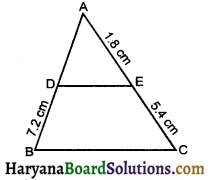
Solution :
We have
AE = 1.8 cm, BD = 7.2 cm, CE = 5.4 cm and DE || BC
∴ \(\frac{\mathrm{AD}}{\mathrm{BD}}=\frac{\mathrm{AE}}{\mathrm{CE}}\)
[By theorem 6.1 (BPT)]
⇒ \(\frac{\mathrm{AD}}{\mathrm{7.2}}=\frac{\mathrm{1.8}}{\mathrm{5.4}}\)
⇒ AD = \(\frac{7.2 \times 1.8}{5.4}\)
⇒ AD = \(\frac{7.2 \times 1.8}{54}\) = 2.4 cm
![]()
Question 2.
In the given fig. ∠D = ∠E and \(\frac{\mathrm{AD}}{\mathrm{DB}}=\frac{\mathrm{AE}}{\mathrm{EC}}\) prove that ΔBAC is an isosceles triangle.
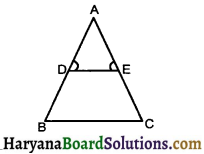
Solution :
We have, In triangle ABC,
\(\frac{\mathrm{AD}}{\mathrm{DB}}=\frac{\mathrm{AE}}{\mathrm{EC}}\)
⇒ DE || BC (By converse of BPT)
DE || BC and AD is a transversal line
∠D = ∠B (Corresponding angles) … (1)
DE || BC and AC is a transversal line, So, ∠E = ∠C (Corresponding angles) …(2)
But ∠D = ∠E ……(3)
From equ. (1), (2) and (3) we get
∠B = ∠C
⇒ AB = AC [Sides opp. to equal angles are equal]
Hence Proved.
Question 3.
In the adjoining figure, DE || AC and DC || AP. Prove that \(\frac{\mathrm{BE}}{\mathrm{EC}}=\frac{\mathrm{BC}}{\mathrm{CP}}\)
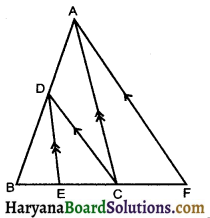
Solution :
In ΔABP, we have DC || AP
∴ \(\frac{\mathrm{AD}}{\mathrm{BD}}=\frac{\mathrm{BC}}{\mathrm{CP}}\) …….(1)
[By BPT]
Again, In ΔABC, we have
DE || AC
∴ \(\frac{\mathrm{AD}}{\mathrm{BD}}=\frac{\mathrm{BE}}{\mathrm{EC}}\) ……….(2)
From equation (1) and (2), we get
∴ \(\frac{\mathrm{AD}}{\mathrm{BD}}=\frac{\mathrm{BE}}{\mathrm{EC}}\)
Hence Proved.
Question 4.
In the adjoining figure, if ΔABC ~ ΔDEF and their sides of length (in cm) are marked along them, then find the lengths of the sides of each triangle.
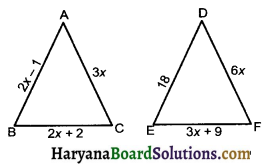
Solution :
We have, ΔABC ~ ΔDEF
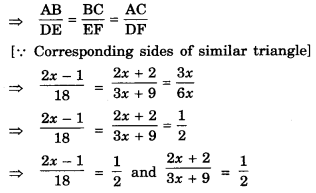
⇒ 2x – 1 = \(\frac {18}{2}\) and 4x + 4 = 3x + 9
⇒ 2x = 9 + 1 and 4x – 3x = 9 – 4
⇒ 2x = 10 and x = 5
⇒ x = 5 and x = 5
Substituting the value of x in the length of sides of two triangles, we get
AB = 2x – 1 = 5 × 2 – 1 = 9 cm
BC = 2x + 2 = 5 × 2 + 2 = 12 cm
AC = 3x = 5 × 3 = 15 cm
DE = 18, EF = 3x + 9
= 3 × 5 + 9 = 24 cm
And DF = 6 × x = 6 × 5 = 30 cm
Hence, sides of ΔABC are 9cm, 12 cm, 15 cm, and sides of ΔDEF are 18 cm, 24 cm and 30 cm.
![]()
Question 5.
In similar triangle ABC and PQR, AD and PM are the medians respectvely, prove that \(\frac{\mathrm{AD}}{\mathrm{PM}}=\frac{\mathrm{AB}}{\mathrm{PQ}}\)
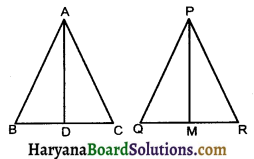
Solution :
Given : AD and PM are medians of ΔABC and ΔPQR and ΔABC ~ ΔPQR.
To prove : \(\frac{\mathrm{AD}}{\mathrm{PM}}=\frac{\mathrm{AB}}{\mathrm{PQ}}\)
Proof : ΔABC ~ ΔPQR
∴ ∠B = ∠Q
(Corresponding ∠S of similar triangles)….(1)
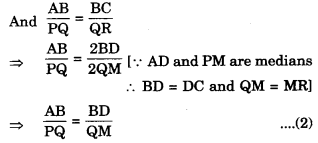
and ∠B = ∠Q [proved above] …………..(1)
From (1), ∠2, ΔABC ~ ΔPQM [By SAS similarity criterian]
⇒ \(\frac{\mathrm{AB}}{\mathrm{PQ}}=\frac{\mathrm{AD}}{\mathrm{QM}}\)
[Corrosponding sides of similar triangles]
Question 6.
X is a point on side BC of ΔABC, XM and XN are drawn parallel to AB and AC respectively meeting AB in N and AC in M. MN produced meets CB produced at T. Prove that TX2 = TB × TC
Solution :
In ΔTCM, XN||CM
∴ ΔTXN ~ ΔTCM
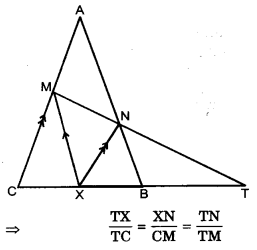
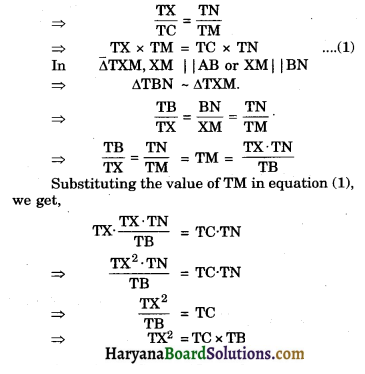
![]()
Question 7.
Given ΔABC ~ ΔPQR, if \(\frac{\mathrm{AB}}{\mathrm{PQ}}=\frac{\mathrm{1}}{\mathrm{3}}\) then \(\frac{a r(\triangle \mathrm{ABC})}{a r(\Delta \mathrm{PQR})}\) = …………..
Solution :
Since ΔABC ~ ΔPQR
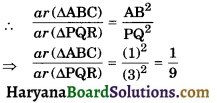
Question 8.
ΔABC and ΔBDE are two equilateral triangle such that D is the mid point of BC. Ratio of the areas of triangles ABC and BDE is …………………
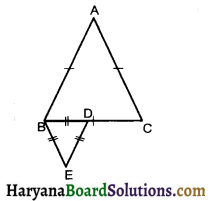
Solution :
Let each side of equilateral ABC be 2x units then BD = \(\frac {2x}{2}\) [D is the mid point of BC]
⇒ BD = x units
Each of anlge ΔABC is 60° (equilateral Δ)
Each angle of ΔBDE is 60° (equilateral Δ)
ΔABC ~ ΔBDE (By AAA similarity criterian)

Question 9.
The area of two similar triangles are in the ratio 16 : 18. Find the ratio of its sides.
Solution :
Let ΔABC ~ ΔPQR
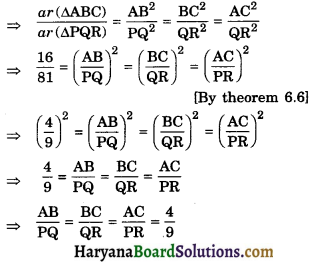
Question 10.
If the ratio of corresponding medians of two similar triangles are 9 : 16, then find the ratio of their area.
Solution :
We have,
Ratio of corresponding medians of two similar triangles = 9 : 16
We know that, Ratio of the areas of two similar triangles is equal to the square of the ratio of their corresponding medi
= 81 : 256
![]()
Question 11.
If ΔABC – ΔDEF in which AB = 1.6 cm and DE = 2.4 cm. Find the ratio of areas of ΔABC and ΔDEF.
Solution :
∵ ΔABC ~ ΔDEF
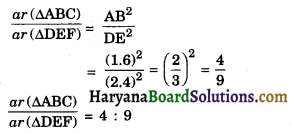
Question 12.

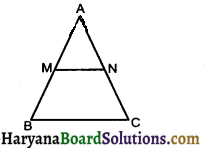
Solution :
We have, In ΔABC, MN || BC
∴ ΔAMN ~ ΔABC
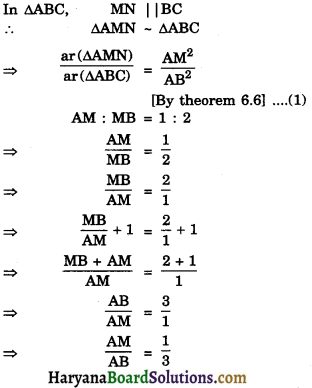
Substituting the value of \(\frac {AM}{AB}\) in the equation (1), we get

Question 13.
In the given figure, ∠ACB = 90° and CD ⊥ AB. Prove that CD2 = BD × AD.
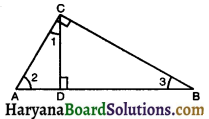
Solution :
Given : A ΔABC i. which ∠ACB = 90° and CD ⊥ AB
To prove : CD2 = BD × AD
Proof: In Right ΔADC,
∠1 + ∠2 + ∠ADC = 180°
⇒ ∠1 + ∠2 + 90° = 180°
⇒ ∠1 + ∠2 = 180° – 90°
⇒ ∠1 + ∠2 = 90° …………..(1)
Similary in right ΔACB,
∠2 + ∠3 = 90° ……….(2)
From (1) and (2), we get
∠1 + ∠2 = ∠2 + ∠3
⇒ ∠1 = ∠3.
In ΔADC and ∠CDB
∠1 = ∠3 (proved above)
∠ADC = ∠CDB (each = 90°)
∴ ΔADC ~ ΔCDB
[By AA similarity criterion]
∴ \(\frac{\mathrm{AD}}{\mathrm{CD}}=\frac{\mathrm{CD}}{\mathrm{BD}}\)
⇒ CD2 = BD × AD
Hence Proved
![]()
Question 14.
ΔABC is a right triangle in which ∠C = 90° and CD ⊥ AB. If BC = a, CA = b, ABC and CD = p, then prove that :
(i) cp = ab
(ii) \(\frac{1}{\mathrm{p}^2}=\frac{1}{\mathrm{a}^2}+\frac{1}{\mathrm{~b}^2}\)
Solution :
(i) Area of right ΔABC
= \(\frac {1}{2}\) base × height
= \(\frac {1}{2}\) a × b
= \(\frac {1}{2}\) ab …(1)
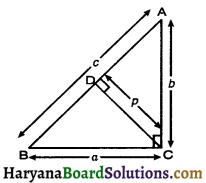
Again, Area of right ΔABC
= \(\frac {1}{2}\) × base × height
= \(\frac {1}{2}\) × c × p
= \(\frac {1}{2}\) × cp …(2)
From (1) and (2), we get
\(\frac {1}{2}\)ab = \(\frac {1}{2}\)cp
⇒ ab = cp
Hence Proved
(ii) In right ΔACB,
AB2 = BC2 + AC2
⇒ c2 = a2 + b2 ……………(3)
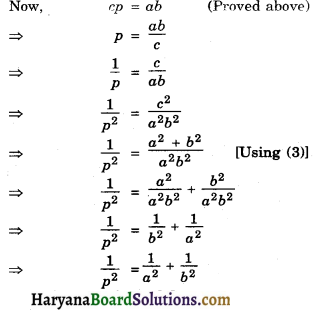
Hence Proved
Question 15.
If P and Q are points on sides CA and CB respectively of ΔABC, right angled at C. Prove that (AQ2 + BP2) – (AB2 + PQ2)
Solution :
Given: A right triangle ABC in which ∠C = 90°, P and Q are points on sides CA and CB respectively.
Construction: Join AQ, BP and PQ.
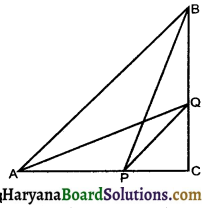
To prove : AQ2 + BP2 = AB2 + PQ2
Proof : In right ΔACQ. we have
AQ2 = AC2 + QC2 ……………(1)
In right ΔBPC, we have
BP2 = CP2 + BC2 ………………(2)
Adding equ. (1) and (2), we get
AQ2 + BP2 = AC2 + QC2 + CP2 + BC2
= (AC2 + BC2) + (CP2 + QC2)
= AB2 + PQ2
[∵ AC2 + BC2 = AC2 and CP2 + QC2 = PQ2]
Fill in the Blanks
Question 1.
If the basector of an angle of a triangle ………….. the opposite side then triangle is an equilateral triangle.
Solution :
bisects
![]()
Question 2.
Thales theorem is also known as basic ………
Solution :
proportionality
Question 3.
All equilateral triangles are …………
Solution :
similar
Question 4.
Phythagoras theorem is sometimes also referred to as the ……………. theorem.
Solution :
Baudhayan
Question 5.
If a line divides any two sides of a triangle in the same ………… then line is parallel to the third side.
Solution :
ratio
![]()
Question 6.
If corresponding angles of two triangles are equal, then they are known as ………….. triangles.
Solution :
equiangular.
Multiple Choice Questions
Question 1.
In equilateral ΔABC, AD is altitude. Then 4AD2 equals.
(a) 2BD2
(b) 2DC2
(c) BC2
(d) 3AB2
Solution :
(d) 3AB2
In ΔADB and ΔADC
AB = AC
∠ADB = ∠ADC
AD = AD
∴ ΔADB ≅ ΔADC
∴ BD = CD (CPCT)
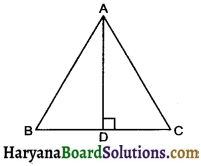
In right ΔADB AB2 = AD2 + BD2
AB2 = AD2 + \(\frac {1}{4}\)AB2
⇒ 4AD2 = 3AB2
So correct choice is (d)
Question 2.
In rhombus PQRS, PQ2 + QR2 + RS2 + SP2 = ?
(a) OP2 + OQ2
(b) OQ2 + OR2
(c) OR2 + OS2
(d) PR2 + QS2
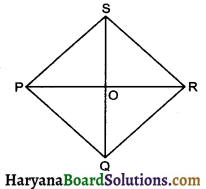
Solution :
(d) PR2 + QS2
4PQ2 = PR2 + QS2
4QR2 = PR2 + QS2
4RS2 = PR2 + QS2
4PS2 = PR2 + QS2
∴ PQ2 + QR2 + RS2 + PS2 = PR2 + QS2
So correct choice is (d)
![]()
Question 3.
In figure, DE || BC, AD = 2.4 cm, AE = 3.2 cm, CE = 4.8 cm. The value of BD is :
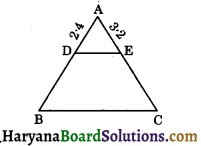
(a) 3.6 cm
(b) 4.2 cm
(c) 4.0 cm
(d) None of these.
Solution :
(a) 3.6 cm
Given AD = 2.4 cm
AE = 3.2 cm
EC = 4.8 cm
Let DB = x
We know that \(\frac{\mathrm{AD}}{\mathrm{BD}}=\frac{\mathrm{AE}}{\mathrm{EC}}\)
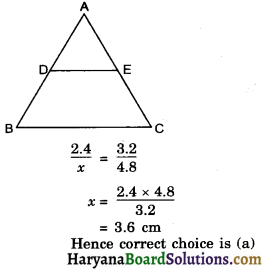
Hence correct choice is (a)
Question 4.
In the given figure, ∠BAC = 90° and AD ⊥ BC, then,
[NCERT Exemplar Problems]
(a) BD.CD = AD2
(b) AB.AC = BC2
(c) BC.CD = BC2
(d) AB.AC = AD2
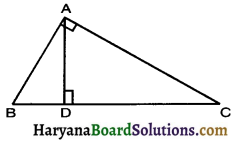
Solution :
(a) BD.CD = AD2
Since
ΔBDA ~ ΔADC
⇒ \(\frac{\mathrm{BD}}{\mathrm{AD}}=\frac{\mathrm{AD}}{\mathrm{CD}}\)
⇒ AD2 = BD.CD
So correct choice is (a).
![]()
Question 5.
If ΔABC – ΔEDF and ΔABC is not similar to ADEF, then which of the following is not true?
[NCERT Exemplar Problems]
(a) BC.EF = AC.FD
(b) AB.EF = AC.DE
(c) BC.DE = AB.EF
(d) BC.DE = AB.FD.
Solution :
(c) BC.DE = AB.EF
ΔABC ~ ΔEDF
ΔABC not similar to ΔDEF
ΔABC ~ ΔEDF
